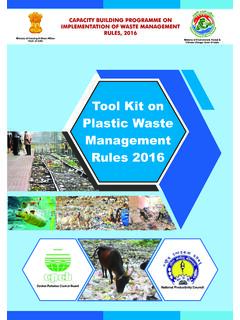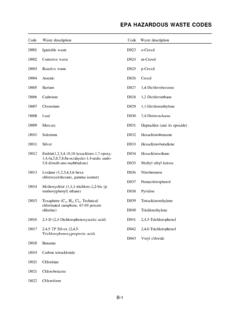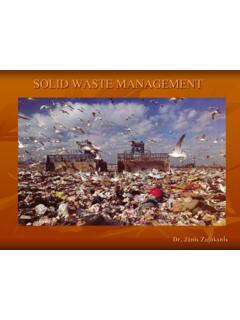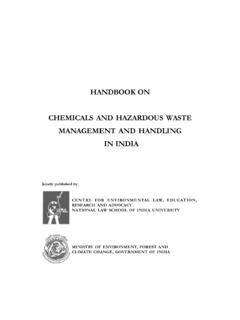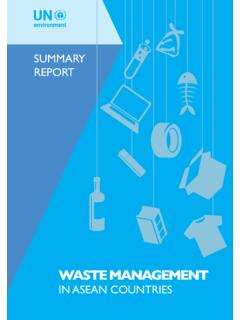Transcription of HAZARDOUS WASTE MANAGEMENT RULES-2016
1 Ministry of Environment, Forest &Climate Change, Govt. of IndiaMinistry of Housing & Urban AffairsGovt. of IndiaCentral Pollution Control BoardNational Productivity CouncilCAPACITY BUILDING PROGRAMME ON IMPLEMENTATION OF WASTE MANAGEMENT RULES, 2016 HAZARDOUS WASTE MANAGEMENT RULES-2016 HAZARDOUS & OTHER WASTES ( MANAGEMENT AND TRANSBOUNDARY MOVEMENT) RULES, 2016 Overview of HAZARDOUS &Other WASTE ManagementFeatures of HAZARDOUS WASTE Rules 2016 MANAGEMENT & Recycling of HAZARDOUS wasteDu es of stakeholdersYour Guide ForHAZARDOUS & OTHER WASTESst1 Edi onJune, 2019 PrefaceNa onal Produc vity Council (NPC) presents the Tool Kit is pleased to present to you the 'Toolkit for implementa on of HAZARDOUS WASTE MANAGEMENT rules, 2016'. This toolkit has been cra ed specially for reference forby all the the stakeholders involved in the genera on, collec on, storage, transporta on, treatment & disposal of HAZARDOUS WASTE .
2 Further, it is published as a reference for ci zens , ins tu ons interested to explore and understand the key features of the rules no fied in tool kit describes HAZARDOUS WASTE Classifica on and Operatorss' Requirements, aspects of Import & Export of HAZARDOUS & Other Wastes, Record keeping, HAZARDOUS WASTE Generator Training Requirements, Disposal of HAZARDOUS provides useful ps, FAQs, do's and don'ts, methods and prac ces that should be followed in the HAZARDOUS solid WASTE MANAGEMENT toolkit has been brought together by a team of good technocrats and environmentalists, including from various regulatory authori es in the country. It has been furthercarefully reviewed by toolkit also provide Standard Opera ng Procedures (SOP)s for MANAGEMENT of available specific HAZARDOUS would welcome any sugges ons and feedback on this publica on so that 'The Toolkit' becomes a usefultrusted companion & compendium for reference by stakeholders in Indiaand part of all D.
3 BhardawajRegional Director, DelhiNa onal Produc vity CouncilCompiled & Edited by:Na onal Produc vity CouncilNote: 1. All pictures used in the toolkit are from various sources, which have been duly referred to. 2. This publica on is purely for educa on purpose and not for commercial Air Pollu on Control DeviceCHWTSDF Common HAZARDOUS WASTE Treatment, Storage & Disposal FacilityCPCB Central Pollu on Control BoardDRE Destruc on & Removal EfficiencyEPA Environment Protec on AgencyETP Effluent Treatment PlantEU European UnionFAQ Frequently Asked Ques onsGHG Green House GasesHOWMTM HAZARDOUS & Other Wastes Transboundary MovementHW HAZARDOUS WasteKLPD Kilo Liter Per DayLQG Large Quan ty GeneratorMOEF&CC Ministry of Environment, Forest & Climate ChangeMTA Million Tons per AnnumPPE Personneal Protec on EquipmentSPCB State Pollu on Control BoardSOP POP Standard Proposed Opera ng ProcedurePrac ceSLF Secured Landfill FacilitySQG Small Quan ty GeneratorSTLC Soluble Threshold Limit Concentra onTCLP Toxicity Characteris c Leaching ProcedureTTLC Total Threshold Limit Concentra onTPA Tonnes Per AnnumTSDF Treatment, Storage & Disposal FacilityUSEPA United States Environment Protec on AgencyTable of ContentsS.
4 No. Content Page Introduc on 1 HAZARDOUS WASTE Policy Framework 4 HAZARDOUS WASTE Defini on 42. HAZARDOUS WASTE Classifica on and Operators Requirements 5 How to Iden fy HAZARDOUS & Other Wastes 8 Responsibili es of Occupier 9 Storage Requirements 10 Labeling Requirements 11 HAZARDOUS WASTE Accumula on/Storage Area 11 HAZARDOUS WASTE Compa bility 12 Container MANAGEMENT 153 Import & Export of HAZARDOUS & Other Wastes 15 Responsibili es of Importer 16 Procedure for Export of HAZARDOUS & Other Wastes from India 16 Illegal Traffic 164 Record keeping 185 HAZARDOUS WASTE Generator Training Requirements 18 Training Requirements for Small Quan ty Generators (SQG) 18 Training Requirements for Large Quan ty Generators (LQG) 19 Training Plan 196 HAZARDOUS & Other WASTE MANAGEMENT 20 WASTE Minimiza on/Cleaner Produc on 22 Co-processing of HAZARDOUS WASTE 24 Benefits of Co-processing in Cement Industry 25 Material & Energy Recovery 26 Best Prac ces of HAZARDOUS WASTE u liza on other than Co-processing 297 Disposal 30 Quality MANAGEMENT System 31 Se ng up of Common HAZARDOUS WASTE Treatment, Storage and Disposal 32 Facili es (CHWTSDF)8 HAZARDOUS WASTE Emergency/Con ngency Plan 38 General Requirements 38 Use of Con ngency Plan 38 Emergency Communica on 39 Emergency Response Equipment 39 Appendix A: Important Defini ons 40 Appendix B: List of HAZARDOUS Characteris cs as per Rules, 2016 43 Appendix C: Proposed Opera ng Prac ces 47 Appendix D: Frequently Asked Ques ons (FAQs) 77 Appendix E: Do s and Don ts 85 Appendix F.
5 Forms as per Rules, 2016 INTRODUCTION Rapid industrializa on in last fewrecent decades have led to the deple on of natural resources and increase in pollu on in the country. As part of economic development, this industrializa on has also led to genera on of huge quan es of HAZARDOUS WASTE which causes severe environmental problems. These industrializa on has also led,apart from economic development, to the genera on of huge quan es of HAZARDOUS WASTE which causes sewer environmental problems. Therefore, scien fic treatment and systema c disposal of generated WASTE is a necessity. HAZARDOUS WASTE is a complex problem as it poses threat not only to the environment but also to the human health. It requires sophis cated and specialized treatment due to the presence of a mixture of chemicals and substances. Basically, the HAZARDOUS wastes are generated because of the following reasons:a) Use of HAZARDOUS Substances:- Generally, most of the HAZARDOUS wastes are generated during the produc on and consump on and produc on of chemicals.
6 The genera on of such wastes is increasing with the increase in the demand of the consumer ) Use of Inappropriate Technologies:- Many industries, in par cular small & medium enterprises (SMEs) use outdated or obsolete technologies due to economic and technical constraints. As a result the resource conversion is not op mum, resul ng in high & more toxic and/or HAZARDOUS ) End of Pipe Treatment of Effluent/Emissions:-The treatment of wastewater streams and gaseous emissions to meet the standards, result into residues that contain HAZARDOUS cons of Environment, Forest and climate Change (MoEF & CC) formerly known as Ministry of Environment and Forest (MoEF) promulgated HAZARDOUS WASTE ( MANAGEMENT and Handling) Rules, 1989, under the provision of the Environment Protec on Act, 1986. In September 2008 the said rules were amended and new rules en tled HAZARDOUS WASTE ( MANAGEMENT , Handling and Transboundary Movement) Rules, 2008 were promulgated.
7 These rules were further amended in the year 2009 & 2010 for proper MANAGEMENT and handling of HAZARDOUS WASTE in the country (CPCB, 2010-2011). India has also ra fied the Basel conven on on transboundary movement of HAZARDOUS WASTE in the year 1992 and is a signatory to the conven on (Du a SK, 2006). It is an interna onal treaty that was designed to reduce the movements of HAZARDOUS WASTE between na ons, except where it is perceived to be in accordance with principles of environmentally sound MANAGEMENT . The rules have been further amended recently, en tled HAZARDOUS and Other Wastes ( MANAGEMENT and Transboundary Movement) Rules, 2016, to include other wastes such as WASTE tyre, paper WASTE , metal scrap, used electronic items, per the CPCB es mates in 2010latest sta s cs, about million tonnes per year of HAZARDOUS WASTE is generated from about 40,722 industries. About MTPA ( ) landfillable; MTPA ( ) recyclable and MTPA ( ) is incinerable WASTE , out of the total HAZARDOUS 1waste generated in the country.
8 About 83% of total HAZARDOUS WASTE isn generated from in seven states viz.; Gujarat, Maharashtra, Tamil Nadu, Andhra Pradesh, West Bengal and Cha sgarh. There are about 29 Common Secured Landfill Facili es in 16 states and 14 Common Incinerators in 7 states in order to manage HAZARDOUS wastes in environmentally sound per the Compendium of Environmental Sta s cs India, 2016, about 90% of the total HAZARDOUS WASTE generated in the country is being contributed by ten (10) states and out of these, the industries in three states viz.; Maharashtra, Gujarat and Andhra Pradesh contribute about 60% of total HAZARDOUS WASTE . Most of the HAZARDOUS WASTE is being generated from chemical produc on & metal processing industries apart from the treatment of wastewater and flue gases. The state wise HAZARDOUS WASTE genera on along with percentage recyclable is presented in the following Table 1 and Figure 1 & : State wise HAZARDOUS WASTE Genera on in IndiaHazardous WASTE Genera on in India (MTPA) States HW Genera on(MTPA) % Recyclable Maharashtra Gujarat Andhra Pradesh Rajasthan Tamil Nadu Madhya Pradesh Cha sgarh Jharkhand U ar Pradesh 76 West Bengal : Showing HAZARDOUS WASTE Genera on in IndiaFigure : Percentage of Recyclable WASTE in various HAZARDOUS & Other Wastes Rules, 2016, Compliance Tool Kit is intended to assist various stakeholders in understanding how to comply with the regula ons governing HAZARDOUS WASTE MANAGEMENT in India and to manage HAZARDOUS wastes in environmentally sound tool kit provides the Do's and Don'ts with respect to MANAGEMENT of HAZARDOUS WASTE .
9 It provides several proposed opera ng prac cesgeneral standard opera ng procedures (PSOPs) that can be customized and adapted as per the individual requirement. HAZARDOUS WASTE POLICY FRAMEWORKH azardous WASTE was first regulated in 1989 through HAZARDOUS WASTE ( MANAGEMENT & Handling) Rules, 1989, which subsequently were amended in 2008 to incorporate Basel Conven on provisions and lastly recently again in 2016. The HAZARDOUS WASTE MANAGEMENT regula ons have undergone sea change since its first promulga on in 1989 to take care of requirements of various stakeholders from me to me. HAZARDOUS WASTE is regulated by the following agencies in India: Ministry of Environment, Forest & Climate Change, Government of India; Central Pollu on Control Board; State Pollu on Control Boards and Pollu on Control Commi HAZARDOUS WASTE DEFINITION What is WASTE ? WASTE " means materials, that are not products or byproducts, for which the generator has no further use for the purposes of produc on, transforma on or consump on.
10 Wastes are the materials that may be generated during, the extrac on of raw materials, the processing of raw materials into intermediates and final products, the consump on of final products, and through other human ac vi es and excludes residuals recycled or reused at the place of genera on. By-product means a material that is not intended to be produced but gets produced in the produc on process of intended product and is used as is HAZARDOUS WASTE ? The primary purpose for a HAZARDOUS WASTE defini on is to help the stakeholders establish whether WASTE is HAZARDOUS or poten ally HAZARDOUS . As per HAZARDOUS and Other Wastes ( MANAGEMENT and Transboundary Movement) Rules, 2016: HAZARDOUS WASTE means any WASTE which by reason of characteris cs such as physical, chemical, biological, reac ve, toxic, flammable, explosive or corrosive, causes danger or is likely to cause danger to health or environment, whether alone or in contact with other WASTE or substances and shall include:i.
